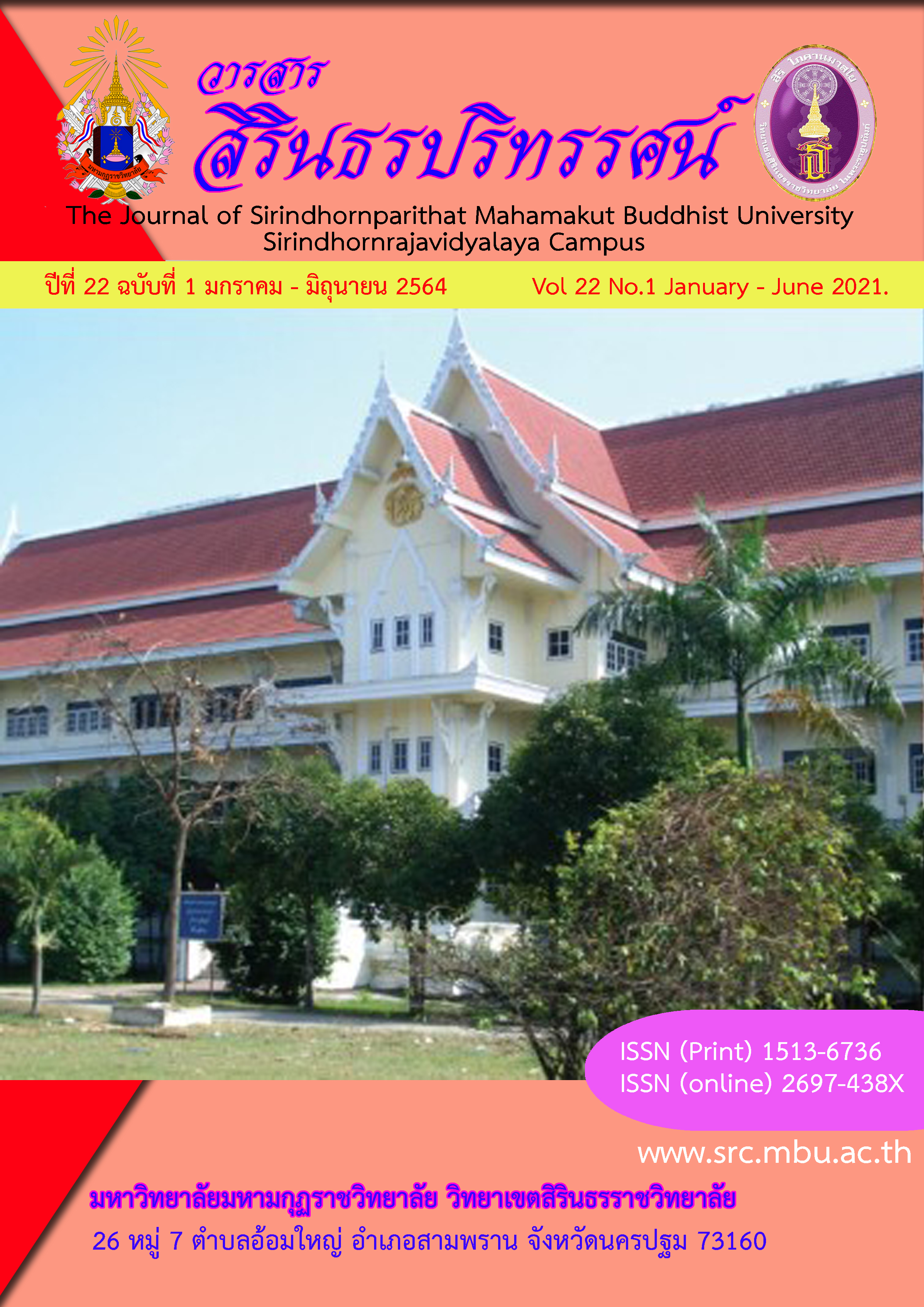THE EDUCATION OF STANDARD TRADITIONAL THAI DANCING BY USING AN INSTRUCTIONAL MODEL BASE ON SIMPSON’S PROCESS FOR PSYCHO – MOTOR SKILL DEVELOPMENT FOR THE GRADE 3 STUDENTS
Keywords:
Standard traditional Thai dancing, Standard traditional Thai dancing Skill, Instructional Model Based on Simpson’s Processes for psycho-Motor Skill DevelopmentAbstract
The objectives of this independent study were 1) to study Standard traditional Thai dancing by using an instructional Model base on Simson's process for Psycho- Motor Skill Development for Grade 3 students, and 2) To compare skills of standard traditional Thai dancing by using an Instructional Model base on Simson's Process for Psycho – Motor skill Development for Grade 3 students with the criteria at 70%. The sample who was Grade 3 students at Boonnadavittaya School in Nakhon Ratchasima for semester 1 of the Academic year 2020 was 32 students. The research instruments consisted of lesson plans based on Simson's Process for Psycho - Motor skill Development, and evaluation form of practical skill of standard traditional Thai dancing in 5 aspects including correct dancing, beautiful dancing, steps of dancing, smooth dancing, and confident show of dancing. The statistics used for data analysis were percentage, mean, standard deviation, and t-test. The research findings were that 1) Skills of Standard Traditional Thai Dancing by using an instructional model based on Simson's Process for Psychomotor Skill Development for Grade 3 Students passed the 70% criteria at 100%. 2) Skills of Standard Traditional Thai Dancing by using an instructional model based on Simson's Process for. Psychomotor Skill Development for Grade 3 Students had posttest scores higher than the criteria at 70 % in the statistically significant differences at the 0.05 level.
References
กิ่งกาญจน์ สิรสุคนธ์. รูบริคหรือรูบริคการให้คะแนน. กรุงเทพฯ: สำนักวิชาการและมาตรฐานการศึกษา.กรมวิชาการ. คณะครุศาสตร์ จุฬาลงกรณ์มหาวิทยาลัย. UTQ-02119 กลุ่มสาระการเรียนรู้ศิลปะ: นาฏศิลป์ [Online] แหล่งสืบค้น: http: WWWww.krukird.com/02119.pdf [2562,กุมภาพันธ์ 10]
ชวลิต สุนทรานนท์. รัจนา พวงประยงค์. บทความรำวงมาตรฐานท่ารำตามแบบแผนสำนักการสังคีตกรมศิลปากร [Online]. แหล่งสืบค้น:https://sites.google.com/site/tayakornwason/hna-erek [2562, มีนาคม 1]
ชุติมา ปาละวงษ์. (2561). การเปรียบเทียบผลสัมฤทธิ์ทางการเรียนวิชานาฏศิลป์เรื่องภาษาท่าทางนาฏศิลป์ของนักเรียนชั้นมัธยมศึกษาปีที่ 3 โรงเรียนมัธยมวัดหนองจอกที่สอนโดยใช้ชุดการสอนกับการสอนแบบปกติ. นักศึกษาระดับบัณฑิตศึกษา สาขาวิชานวัตกรรมหลักสูตรและการจัดการเรียนรู้.
ทิศานา แขกมณี. (2550). ศาสตร์การสอนองค์ความรู้เพื่อการจัดกระบวนการเรียนรู้ที่มีประสิทธิภาพ. กรุงเทพฯ: สำนักพิมพ์จุฬาลงกรณ์มหาวิทยาลัย.
นาฏศิลป์ไทย. (2548). นาฏศิลป์ไทยสำหรับครูประถมศึกษาอุดมศึกษา. กรุงเทพฯ: โอเดียนสโตร์.
บุสรินทร์ พาระแพน1, ประสงค์สายหงส์2. การพัฒนาชุดการเรียนรู้การแสดงนาฏศิลป์พื้นบ้านตามแนวคิดทักษะปฏิบัติของซิมพ์ซันที่ส่งเสริมบุคลิกภาพและความคิดสร้างสรรค์การปฏิบัติท่ารำสำหรับนักเรียนชั้นมัธยมศึกษาปีที่ 3. สาขาวิชาหลักสูตรและการสอน คณะศึกษาศาสตร์มหาวิทยาลัยมหาสารคาม.
ประทิน พวงสำลี. หลักนาฏศิลป์. กรุงเทพฯ : ไทยมิตรการพิมพ์.
มิสธัญพร วงษ์สว่าง. (2553). การพัฒนาชุดการสอนเรื่องนาฏยศัพท์และภาษาท่านาฏศิลป์ไทยสำหรับนักเรียนชั้นประถมศึกษาปีที่ 3. โรงเรียนเซนต์หลุยส์ ฉะเชิงเทรา.
หยาดพิรุณ พวงสุวรรณ์. (2558). การพัฒนาผลสัมฤทธิ์ทางการเรียนโดยใช้ชุดกิจกรรมการเรียนรู้ เรื่องทักษะพื้นฐานและการฝึกหัดการแสดงนาฏศิลป์สาหรับนักเรียนชั้นมัธยมศึกษาปีที่ 1. วิทยานิพนธ์ครุศาสตรมหาบัณฑิต, มหาวิทยาลัยราชภัฏราไพพรรณี.
Boeh and Maeshall. (2000). “The Effective of Labanotation in Learning Ballroom Dance.” Dissertation Abstracts International.
Wilson, Cynthaia Louise. An Analysis of a Direct Instruction Produced in Teaching Word Problem-Solving to Leaming Disabled Students.Dissertation Abstracts International.
Downloads
Published
Issue
Section
License
บทความที่ได้รับการตีพิมพ์เป็นลิขสิทธิ์ของ มหาวิทยาลัยมหามกุฏราชวิทยาลัย วิทยาเขตสิรินธรราชวิทยาลัย
ข้อความที่ปรากฏในบทความแต่ละเรื่องในวารสารวิชาการเล่มนี้เป็นความคิดเห็นส่วนตัวของผู้เขียนแต่ละท่านไม่เกี่ยวข้องกับหาวิทยาลัยมหามกุฏราชวิทยาลัย วิทยาเขตสิรินธรราชวิทยาลัย และคณาจารย์ท่านอื่นๆในมหาวิทยาลัยฯ แต่อย่างใด ความรับผิดชอบองค์ประกอบทั้งหมดของบทความแต่ละเรื่องเป็นของผู้เขียนแต่ละท่าน หากมีความผิดพลาดใดๆ ผู้เขียนแต่ละท่านจะรับผิดชอบบทความของตนเองแต่ผู้เดียว




